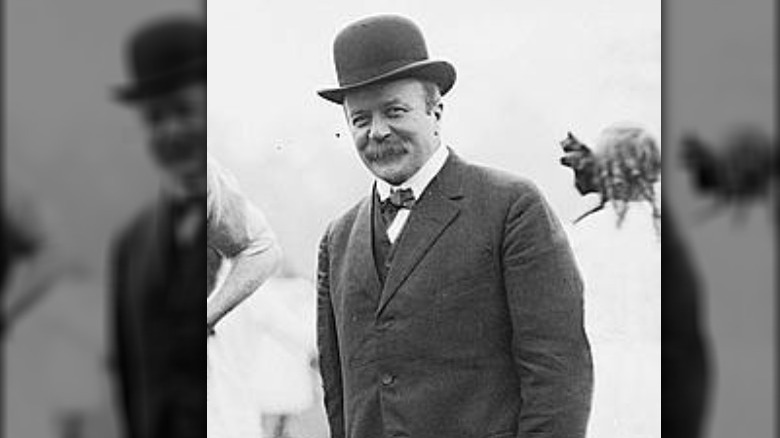How A Lunch Break In 1913 Turned Into An Exhaustive Missing Person Search
Right off of 80th street on New York's west side, there rests a granite bench in the middle of Central Park's Shakespearean Garden. It's known as a "whispering bench," designed so that someone sitting at one end can whisper to someone at the other end, 20 feet away, and be heard perfectly. The structure that curves itself in a regal fashion before tired pedestrians who might need somewhere to sit is really something to behold, though some people might not be familiar with the name inscribed upon it: Charles B. Stover (1861-1929). According to Central Park in Bronze, Stover was one of New York City's most influential and revered philanthropists, and the bench was installed in 1936 to pay homage to him.
NYC Parks reports that Charles Bunstein Stover, a trained Presbyterian minister and social worker, and Lillian Wald, director of the Henry Street Settlement, established the Outdoor Recreation League (ORL) in 1898, an institution that dedicated itself to constructing public playgrounds and safe recreational spaces for children, most of whom came from the city's poorer communities. He went on to become Manhattan Parks Commissioner in 1910 and pioneered a good part of New York's contemporary infrastructure that people still enjoy today. Stover also went missing in 1913 and incited a nationwide manhunt that, luckily, concluded with him being found.
Charles Stover's 39 day lunch break
It was 1913, and Charles B. Stover had been the official Manhattan Parks Commissioner for three years at that point. According to NYC Parks, he told his work associates that he was taking a quick lunch break one afternoon in October and that he would return promptly. To their alarm, Stover never came back from his midday hiatus, and it wasn't long before it was clear that he likely wouldn't be returning any time soon. Local authorities were contacted, and a citywide search (that ultimately proved fruitless) commenced.
"Friends of Park Commissioner Charles B. Stover, who has been missing since Oct. 16, when he went on a vacation without telling any one his destination, are now seriously alarmed over his continued absence, and one suggested yesterday that Mr. Stover might be suffering from amnesia," The New York Times shared in the midst of the sweeping panic. The search for New York's missing Parks Commissioner extended across the country, and just when the Big Apple was about to give up the search for one of its best seeds, Stover reemerged, safe and sound. Apparently, he'd wandered all the way to the Midwest for reasons his community could only guess at.
Why did Charles Stover run off without warning?
At first, people were overjoyed to learn of Charles Stover's safety, but it wasn't long before they wanted answers. When all is said and done, you can't just flee the scene without a word's notice and play hooky from work for nearly a month and a half; and if you do, you'd better have a pretty good reason for it. According to Stover himself, he "made an exhaustive study of parks and municipal conditions" and had visited "practically every important city in the South" (via NYC Parks). While it may have sounded like a proactive excuse, others weren't having it.
According to NYC Parks, New York Mayor Ardolph L. Kline suspended Stover for his little stunt, but Stover one upped him by sending in his permanent resignation from the official Parks Department while he was still in Cincinnati, Ohio (where he was ultimately found). Still, he continued to enrich his community throughout the remainder of his life outside of government work. NYC Parks reports that Stover constructed a youth summer camp in Beacon, New York, whose entryway displays his own personal motto: "One's self must garden and gardener be." He's still remembered as one of the most selfless and celebrated individuals in New York's history.
He never married. He died April 24, 1929, at the age of 67. His estate, worth about $500, went to an uncle, according to his New York Times obituary.


